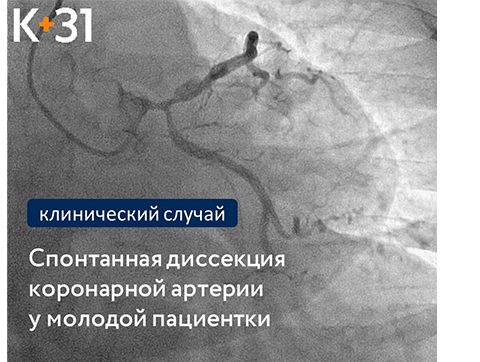Spontaneous dissection of a coronary artery in a young patient

A 48-year-old woman who has never had a heart problem suddenly felt intense pain while driving her car. Being not far from the K+31 clinic, the patient arrived at the emergency department on her own 15 minutes after the onset of pain.
It was not possible to remove the pain syndrome using nitroglycerin and analgesics, which required the introduction of morphine. The diagnosis of the young patient was not completely clear, as there was an infarction-like dynamics on the ECG, but there were no signs of heart damage on echocardiography.
Since most cases of acute heart injury (acute coronary syndrome) are associated with a violation of blood circulation in the arteries of the heart, the woman was urgently taken to the X-ray operating room, where coronary angiography was performed - a study that involves the injection of contrast directly into the arteries of the heart (the "gold" standard for examining patients with ischemic heart disease). Tearing and detachment of the inner wall of the artery of the main artery of the heart (left coronary artery) with 99% occlusion of the lumen were revealed.
It should be noted that the true prevalence of the so-called spontaneous coronary artery dissection is still unknown due to the difficulties of its diagnosis and lack of experience. It is only known that this pathology affects mainly young women against the background of severe psycho-emotional stress. There was also a connection with hormonal abnormalities, mainly in pregnant women. In most cases, with spontaneous dissection, unfortunately, they simply do not have time to seek medical help.
The K+31 clinic performed stenting of the left coronary artery, the complexity of which was the need to both observe "jewelry precision" in order to prevent further detachment of the artery wall, and the operation on the main artery of the heart, which supplies more than 80% of the myocardium.
The operation was successful: pain was relieved, ECG changes regressed. The patient was transferred to the intensive care unit for further observation.
Thank you for providing the clinical case to Ryabenkova Olga Vladimirovna, head of the multidisciplinary inpatient department K+31 on Lobachevskogo, cardiologist, resuscitator.
